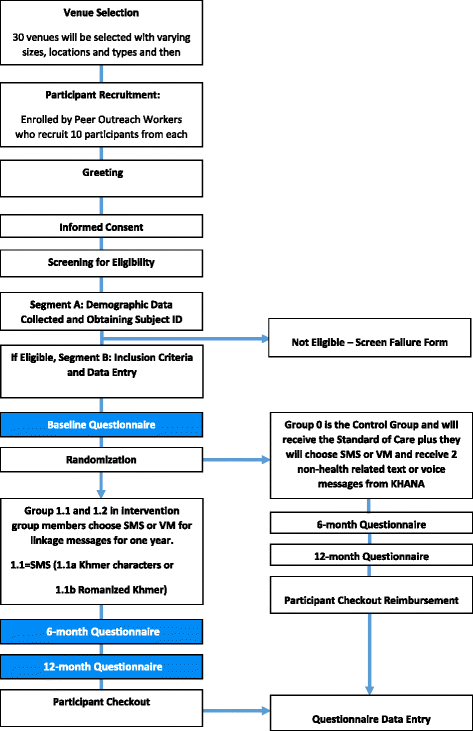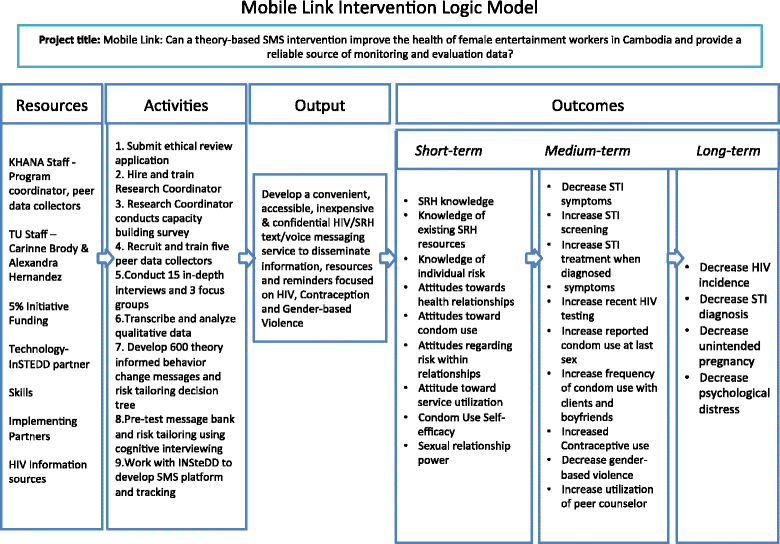Mobile Link - a theory-based messaging intervention for improving sexual and reproductive health of female entertainment workers in Cambodia: study protocol of a randomized controlled trial
- PMID: 29673381
- PMCID: PMC5907699
- DOI: 10.1186/s13063-018-2614-7
Mobile Link - a theory-based messaging intervention for improving sexual and reproductive health of female entertainment workers in Cambodia: study protocol of a randomized controlled trial
Erratum in
-
Correction to: Mobile Link - a theory-based messaging intervention for improving sexual and reproductive health of female entertainment workers in Cambodia: study protocol of a randomized controlled trial.Trials. 2018 Dec 13;19(1):686. doi: 10.1186/s13063-018-3090-9. Trials. 2018. PMID: 30545427 Free PMC article.
-
Correction to: Mobile Link - a theory-based messaging intervention for improving sexual and reproductive health of female entertainment workers in Cambodia: study protocol of a randomized controlled trial.Trials. 2019 Dec 9;20(1):695. doi: 10.1186/s13063-019-3941-z. Trials. 2019. PMID: 31815640 Free PMC article.
Abstract
Background: In Cambodia, HIV prevalence is concentrated in key populations including among female entertainment workers (FEWs) who may engage in direct or indirect sex work. Reaching FEWs with sexual and reproductive health (SRH) services has been difficult because of their hidden and stigmatized nature. Mobile-phone-based interventions may be an effective way to reach this population and connect them with the existing services. This article describes study design and implementation of a randomized controlled trial (RCT) of a mobile health intervention (the Mobile Link) aiming to improve SRH and related outcomes among FEWs in Cambodia.
Methods: A two-arm RCT will be used to determine the effectiveness of a mobile-phone-based text/voice messaging intervention. The intervention will be developed through a participatory process. Focus group discussions and in-depth interviews have been conducted to inform and tailor behavior change theory-based text and voice messages. During the implementation phase, 600 FEWs will be recruited and randomly assigned into one of the two arms: (1) a control group and (2) a mobile phone message group (either text messages [SMS] or voice messages [VM], a delivery method chosen by participants). Participants in the control group will also receive a weekly monitoring survey, which will provide real-time information to implementing partners to streamline outreach efforts and be able to quickly identify geographic trends. The primary outcome measures will include self-reported HIV and sexually transmitted infections (STI) testing and treatment, condom use, contraceptive use, and gender-based violence (GBV).
Discussion: If the Mobile Link trial is successful, participants will report an increase in condom use, linkages to screening and treatment for HIV and STI, and contraception use as well as a reduction in GBV. This trial is unique in a number of ways. First, the option of participation mode (SMS or VM) allows participants to choose the message medium that best links them to services. Second, this is the first RCT of a mobile-phone-based behavior change intervention using SMS/VMs to support linkage to SRH services in Cambodia. Lastly, we are working with a hidden, hard-to-reach, and dynamic population with which existing methods of outreach have not been fully successful.
Trial registration: Clinical trials.gov, NCT03117842 . Registered on 31 March 2017.
Keywords: Cambodia; Female entertainment workers; HIV; Mobile Link; Randomized controlled trial; Sexual and reproductive health; Study protocol; mHealth.
Conflict of interest statement
Authors’ information
CB (PhD) is Associate Professor and Director at Center for Global Health Research, Touro University California, USA. SY (PhD) is Director of KHANA Center for Population Health Research, Cambodia and Adjunct Professor at Touro University California, USA. ST (MA) is Manager; PC (MPH) is Research Fellow; and KCK (MPH) is Research Consultant at KHANA Center for Population Health Research, Cambodia. DS (PhD) is Associate Professor at Department of Psychiatry and Biobehavioral Sciences, University of California, Los Angeles, USA.
Ethics approval and consent to participate
The National Ethics Committee for Health Research of the Ministry of Health, Cambodia (no. 142NECHR) and Touro College Institutional Review Board (no. PH-0117) approved this study, and a verbal informed consent would be obtained from each participant.
Consent for publication
Consent to publish would be obtained from participants as stated in the informed consent form.
Competing interests
The authors declare that they have no competing interests.
Publisher’s Note
Springer Nature remains neutral with regard to jurisdictional claims in published maps and institutional affiliations.
Figures
References
-
- Dammert AC, Galdo JC, Galdo V. Preventing dengue through mobile phones: Evidence from a field experiment in Peru. J Health Econ. 2014;35:147–161. - PubMed
Publication types
MeSH terms
Associated data
Grants and funding
LinkOut - more resources
Full Text Sources
Other Literature Sources
Medical




